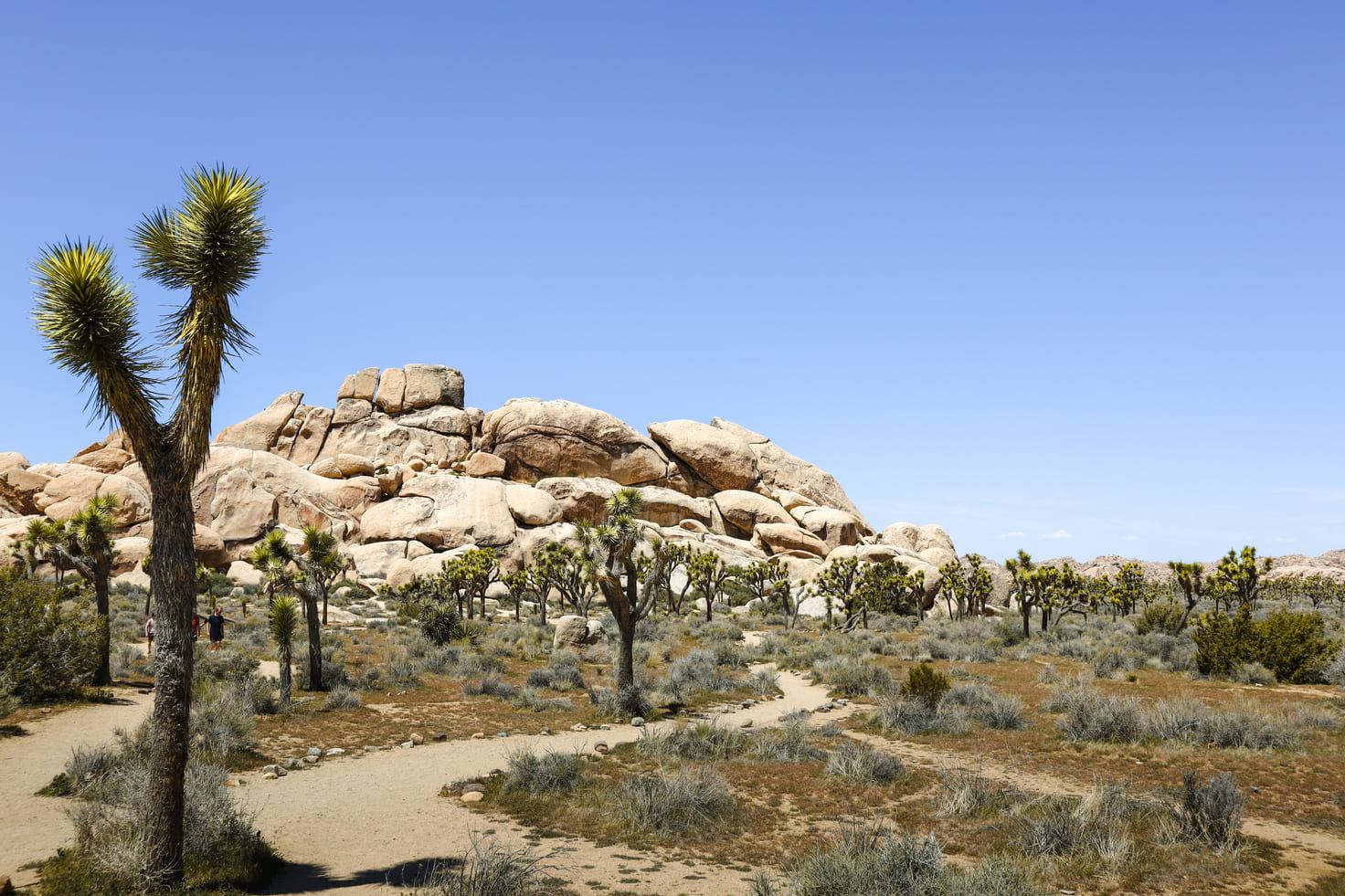Are you looking for a place to visit in California outside the big cities? Then, Joshua Tree National Park could be the perfect solution! From desert landscapes, to fun trails (including some climbing if you’re feeling adventurous), to California’s most photogenic trees, in this post, you’ll find the perfect Joshua Tree National Park itinerary.
Joshua Tree National Park takes its name from the Joshua trees found there. You only have to drive a bit around the park to realise that they can be found easily. These trees are also known as yucca brevifolia and are practically exclusive to the Mojave Desert in the United States.
Their most common name (Joshua tree) was apparently given to them by a group of Mormons because the shape of the trees reminded them of the biblical story of Joshua.

This park is located in the state of California and is made up of two deserts: the Mojave and the Colorado. The Mojave Desert is located in the western part of the park and is cooler and wetter than the Colorado Desert, as it is situated at a higher altitude. The Mojave Desert is where you’ll find the largest number of Joshua trees and also boulders, which are also quite typical in the park. On the other hand, the Colorado Desert is home to other types of flora, such as cholla cacti.
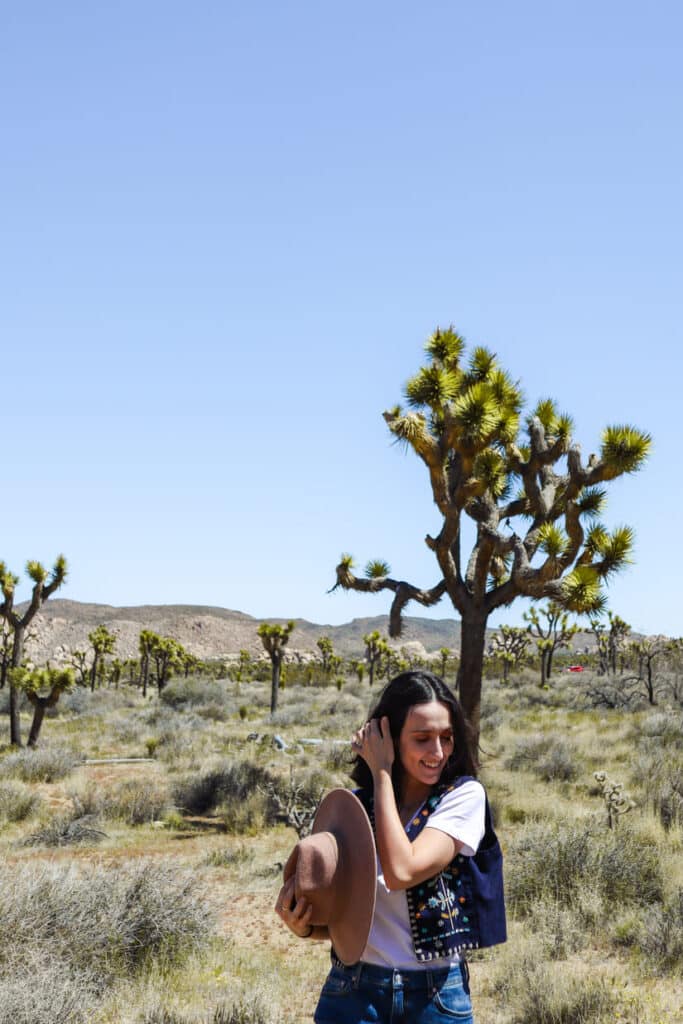
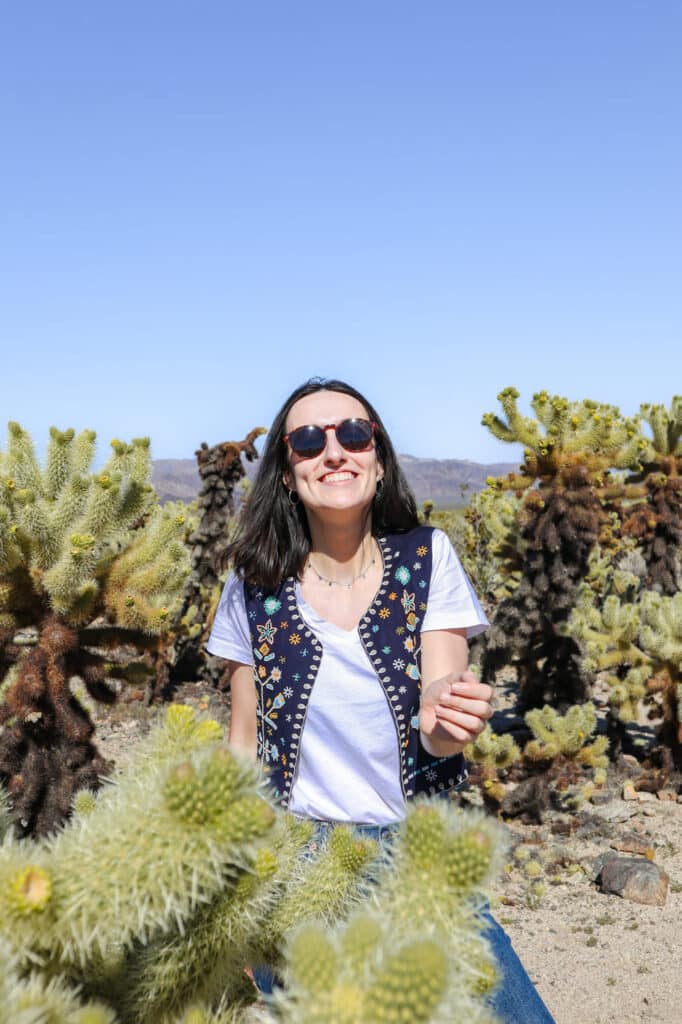
Established as a national park in 1994, Joshua Tree National Park covers more than 3,000 square kilometres, more than 80% of which is wilderness. Although it is far from being one of the largest national parks in the country, it was in the top 10 most visited national parks in the United States in 2023.
Where is Joshua Tree National Park located?
Joshua Tree National Park is located in the state of California and it is relatively close to cities such as Los Angeles. The car journey from Los Angeles to Joshua Tree National Park takes around 2 hours (209 km, 130 miles). However, other cities are also relatively located “close” by, such as:
- San Diego (281 km, 175 miles)
- Las Vegas (346 km, 215 miles)
- Phoenix (358 km, 222 miles)
What is the best time to visit Joshua Tree National Park?
Although Joshua Tree is located between two deserts, winter temperatures can be very low, making this not the ideal time to visit the park. Although during the day the highest temperatures are around 15 °C (59 °F), at night the temperatures can get below freezing and it can snow at the highest points.

Spring and autumn are the two seasons with the most pleasant weather conditions for visiting Joshua Tree National Park. The maximum temperatures range from 21 to 29 °C (69 to 84 °F) and the minimum temperatures are around 10 °C (50 °F). In addition, rain is very rare.
In addition, late winter/early spring (March and May) can be one of the best seasons to see the cacti blooming. However, this phenomenon depends on the amount of rainfall and temperatures each year. For example, I visited in mid-April and still managed to see some flowers.
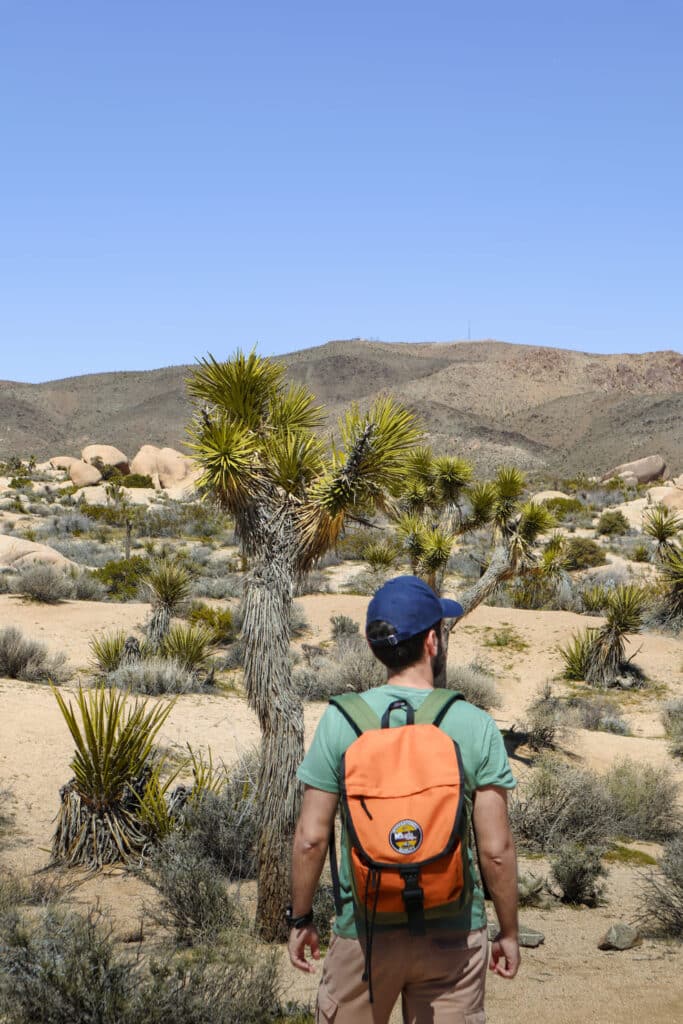
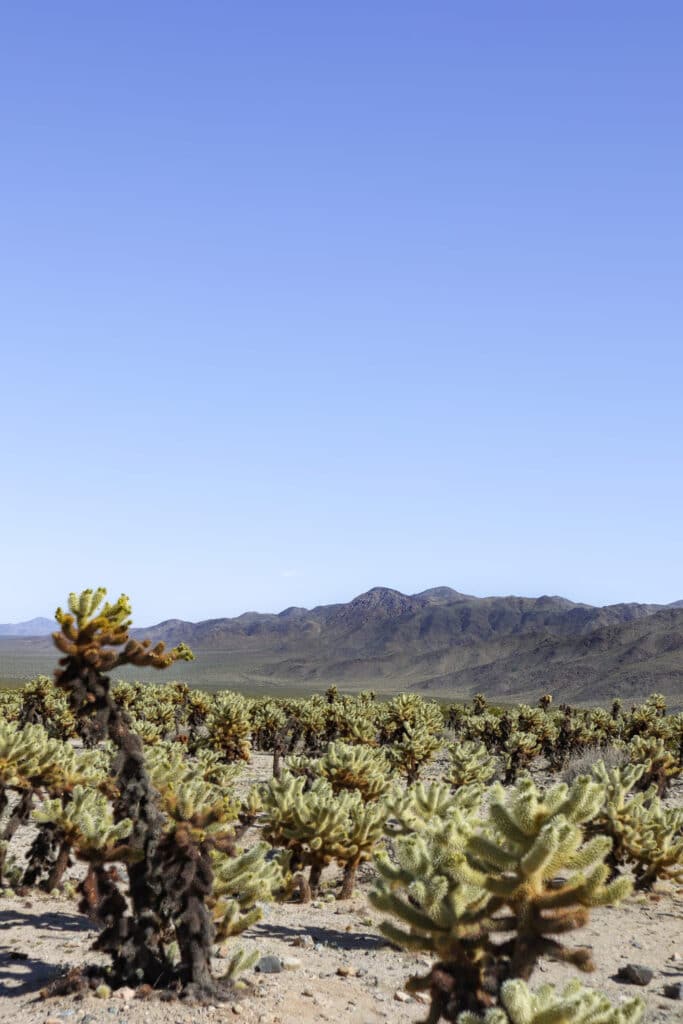
Summer (especially July and August) is also another time of year you should avoid due to the high temperatures, with maximum temperature often reaching 40 °C (104 °F). At this time of year, the lows are around 24 °C (75 °F).
Finally, during the most popular periods (October to May), the park is more crowded and, consequently, it is frequent to find queues to enter the park, greater difficulty in parking inside the park. Plus, you’ll likely find Joshua Tree’s main attractions more crowded as well.
How many days do you need in Joshua Tree National Park?
Although it covers an area of more than 3,000 square kilometres, the best things to do in Joshua Tree are located relatively close together. Entering from the park’s north or west entrance, most of Joshua Tree’s attractions are accessible via Park Boulevard – one of the main roads in the park. Travelling along this road from the park’s north or west entrance takes around 45 minutes.

One day in Joshua Tree is therefore an excellent option for first-time visitors. One day will allow you to visit the must-see places in Joshua Tree National Park, while also giving you time to try out some of the best Joshua Tree trails.
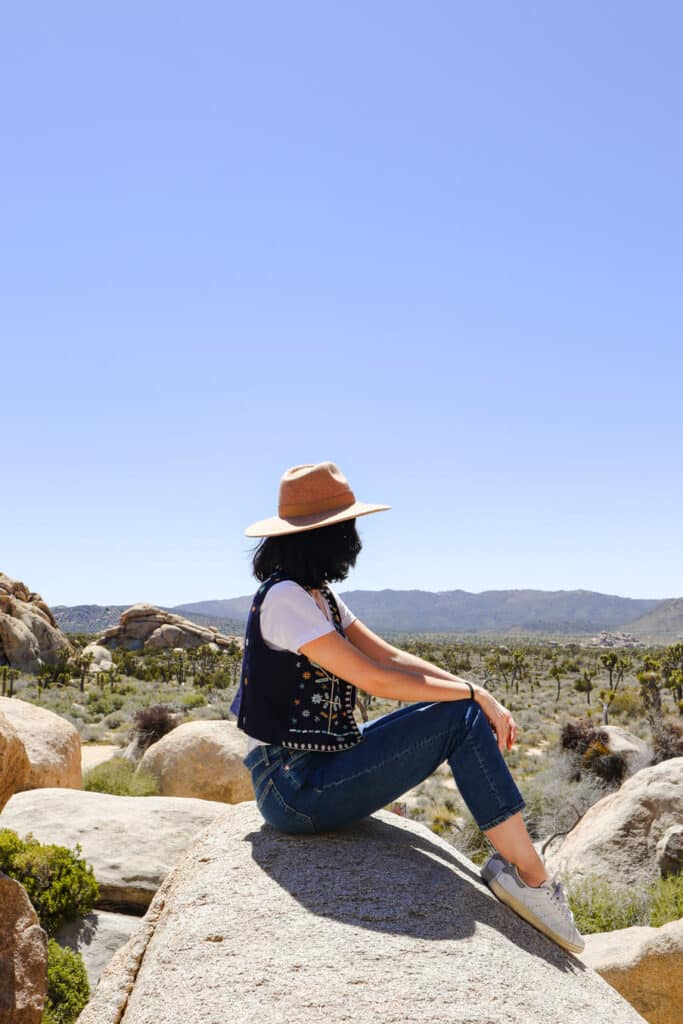
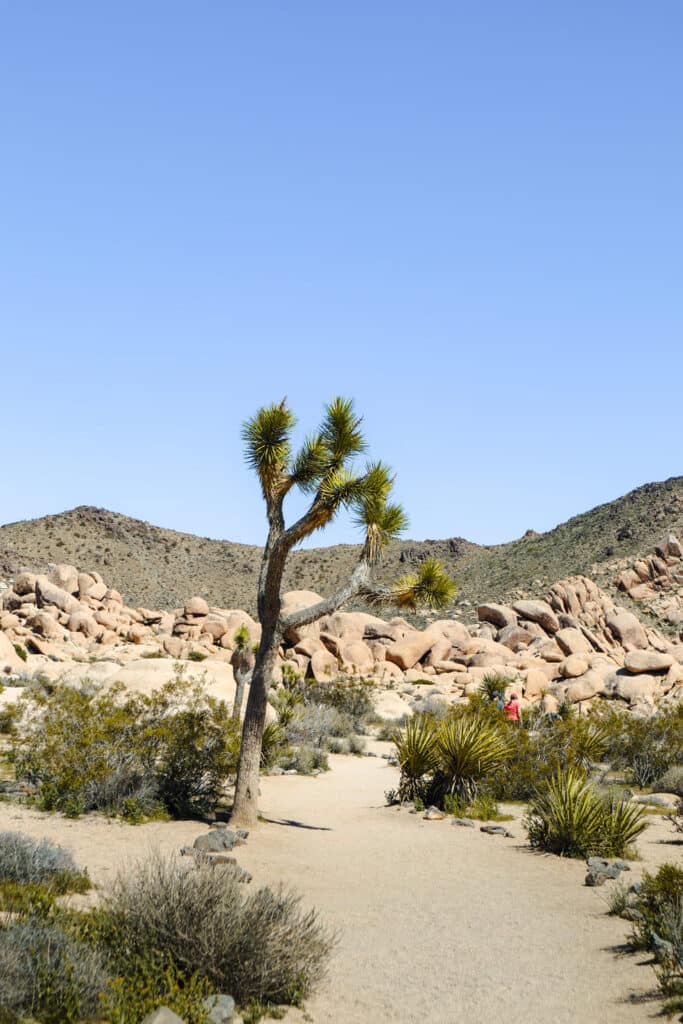
However, the park has lots of interesting activities and we could easily spend another day or two getting to know it. However, if your time is limited, I suggest just one day to get to know the main highlights of Joshua Tree National Park.
💡 EXTRA TIP: My visit to the park started at around 10 am and ended just after 4 pm, and I was able to take in the main sights in Joshua Tree.
What is the price to visit Joshua Tree National Park?
You have to pay an admission fee to visit Joshua Tree. There are various entrance tickets and passes available. For example, entrance fees with a private vehicle are 30 USD (the price is per vehicle, not per person). This entrance fee gives you access to the park for 7 days! There is also an annual pass which costs 55 USD.
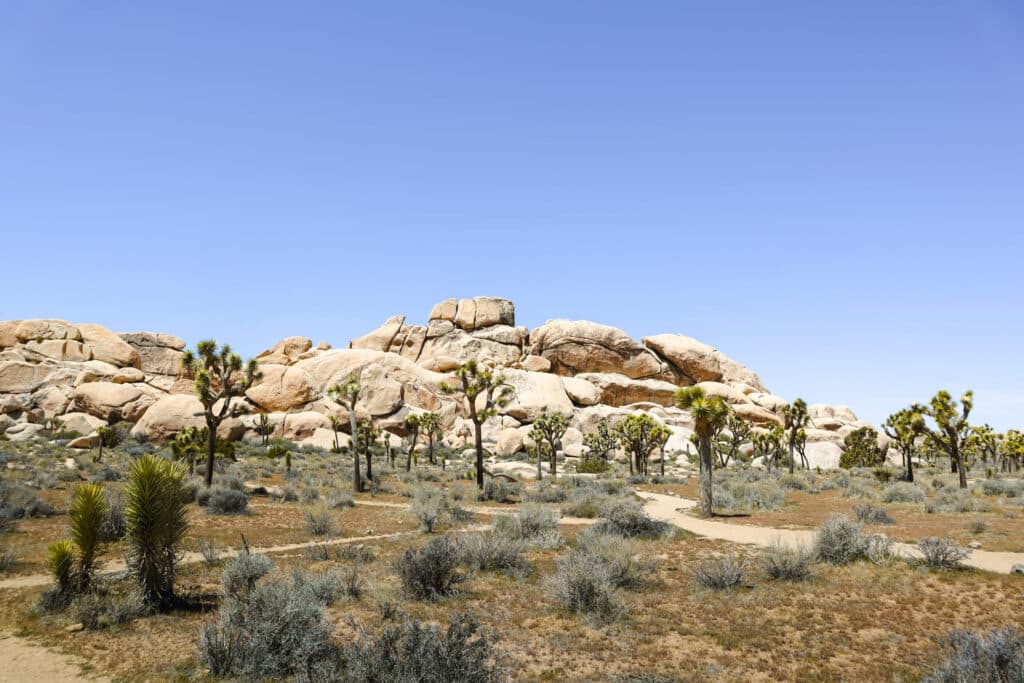
However, if you wish to visit other national parks in the United States, other options are more worthwhile. One such example is the America the Beautiful annual pass. This pass costs 80 USD per vehicle and is valid for one year for all the national parks in the country. Given the average price of entry to the various parks, you only need to visit 3 national parks in a year to make it worth buying America the Beautiful! More information about the passes is available here.
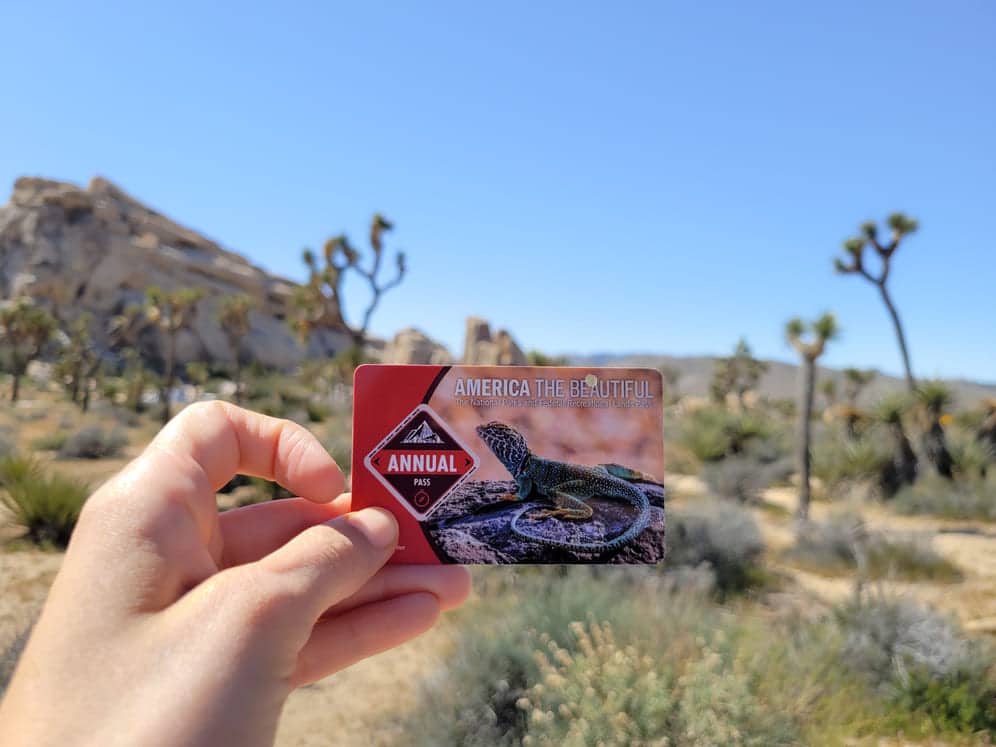
Any of these tickets or passes can be bought at the entrances to the various national parks. I should warn you, however, that some entrances/parks may only accept card payments. You can also buy your entrance tickets online if you wish to spend less time queuing to enter the park😉. Even though it might reduce the time in the queue, you’ll always have to show the pass the enter the park, which can also take some time during peak season.
If you choose to buy the America the Beautiful annual pass, once you’ve bought it, you’ll need to show your pass and ID when entering each park, as the pass is non-transferable.
Is there mobile reception in Joshua Tree?
The mobile coverage in Joshua Tree National Park is quite limited, so you should be prepared for not having access to the internet. In my case, for example, during the whole day I spent in the park, there were very few moments when I had mobile reception. So, I strongly suggest downloading the map of the park area so that it’s available offline on Google Maps.
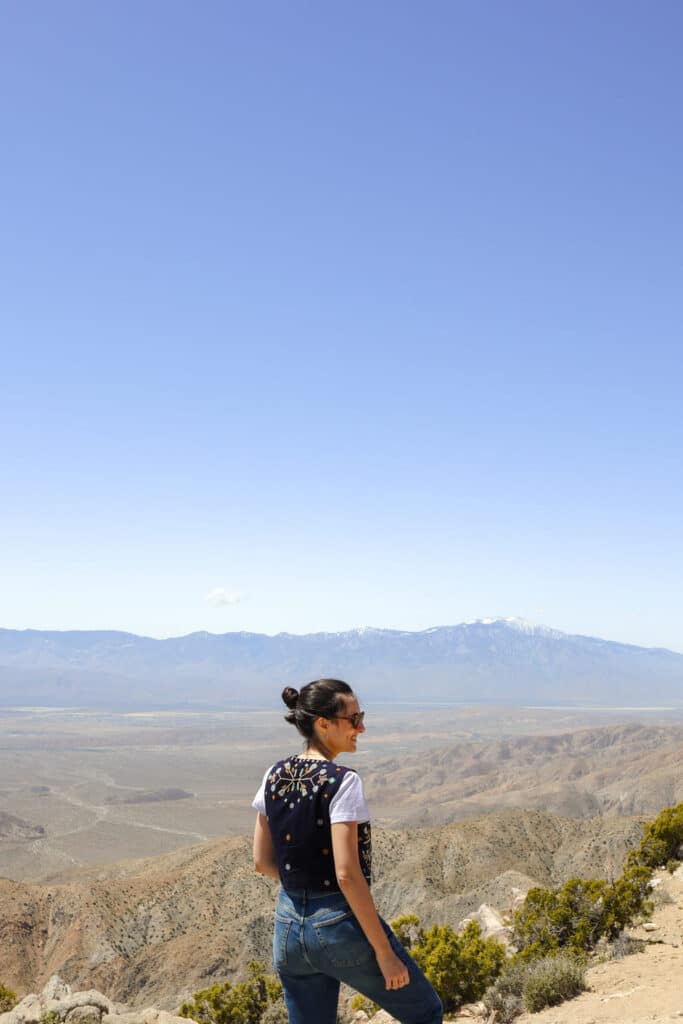

Alternatively, free Wi-Fi is available at the following visitor centres: Black Rock Visitor Centre, Joshua Tree Visitor Centre and Joshua Tree Cultural Centre.
How to get to Joshua Tree National Park?
The closest airport to Joshua Tree National Park is Palm Springs Airport, which is about 50 minutes’ drive from the park.
However, the connections from this airport are mostly domestic. So if you’re planning on travelling to Joshua Tree from an international destination, airports with more international flights such as Los Angeles may be a better option.

If you choose to land in Los Angeles, the best option is to hire a car and drive from Los Angeles to Joshua Tree National Park. The journey takes around 2 hours. Renting a car will also be very useful for getting around the park.
💡 EXTRA TIP: When I visited Joshua Tree, I was doing a road trip through other national parks in the United States. There’s no doubt that renting a car was the best option, as it gave me a lot of freedom to prepare my itinerary. I rented a Toyota RAV4 from Avis in Los Angeles and really enjoyed their service. Although I didn’t need this feature for what I visited in Joshua Tree, I paid a bit more and decided to rent a high-clearance vehicle, which is an excellent option if you want to drive on some of the dirt roads that exist in the US national parks.
What is the best entrance to Joshua Tree National Park?
There are 3 main entrances to Joshua Tree: the West Entrance (the most popular), the North Entrance, in the northern part of the park, but also the entrance near Cottonwood Spring, located in the south of the park.
There isn’t a best entrance, as it depends on what you want to visit and where you’re coming from. Many people choose to take a day trip to Joshua Tree National Park from Los Angeles, in which case the West Entrance makes the most sense.
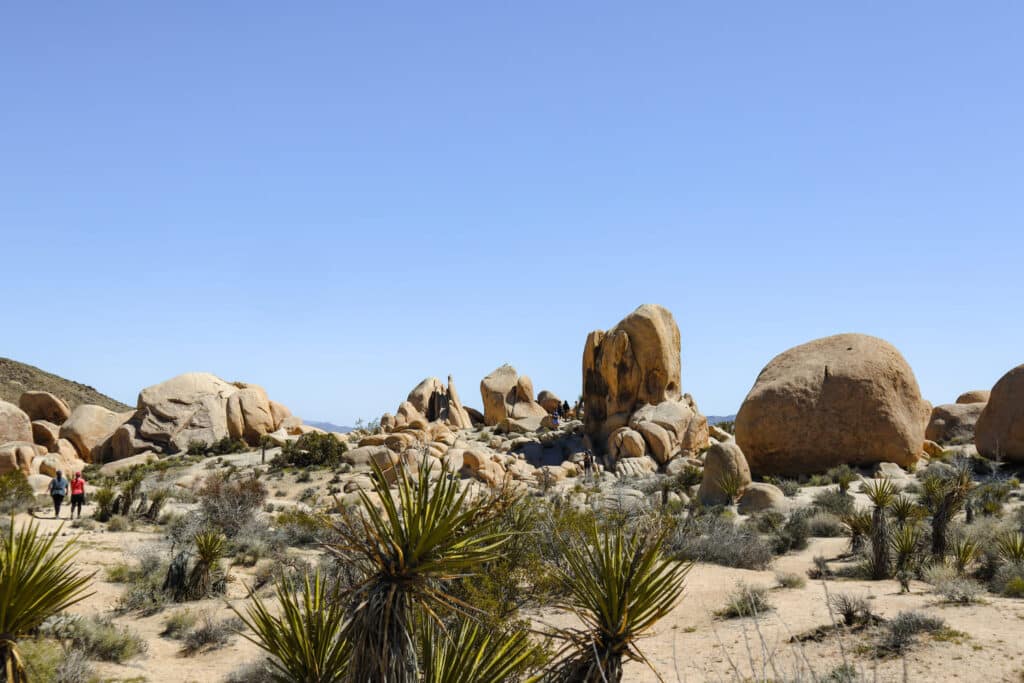
If you visit the park at a busy time of year, I suggest opting for the North Entrance, for example, as there is usually less queuing to get in.
💼 TRAVEL INSURANCE: Unexpected events happen anywhere in the world, so I always recommend getting travel insurance. I regularly use Heymondo, which offers some of the highest coverages on the market at very competitive prices. As well as covering medical expenses, Heymondo’s insurance also covers the loss or theft of luggage, electronic equipment and more. They also have a 24/7 customer service through their App. As A Ticket to Take Off reader, you get a 5% discount when purchasing Heymondo insurance. The purchase must be made using this link, and the price shown on the website already includes the discount.
What is the best way to visit Joshua Tree National Park?
Public transport within the park is non-existent, so the best way to visit the park is with your own vehicle.

For most areas of the park (and the ones I’m going to recommend you visit throughout this post), a “normal” vehicle is enough and you don’t need a 4×4. However, there are some roads in the park (such as Berdoo Canyon Road, Old Dale Road, Black Eagle Mine Road, Pinkham Canyon Road, and Covington Road to Eureka Peak) where a high-clearance vehicle is required.
However, the most popular activities in Joshua Tree National Park don’t involve driving on these roads, so most likely a “normal” car will be more than enough 😉.
Best hotels near Joshua Tree National Park
The best area to stay for those who want to visit this park depends on what you want to visit, where you’re coming from and which entrance you choose.
Accommodation outside Joshua Tree National Park
One of the most popular areas and closest to the park is Twentynine Palms – a small town on the north side of the park, where you’ll find some of the best Joshua Tree hotels as well as a few restaurants. It’s only a 10-minute drive from this town to the park’s North Entrance.

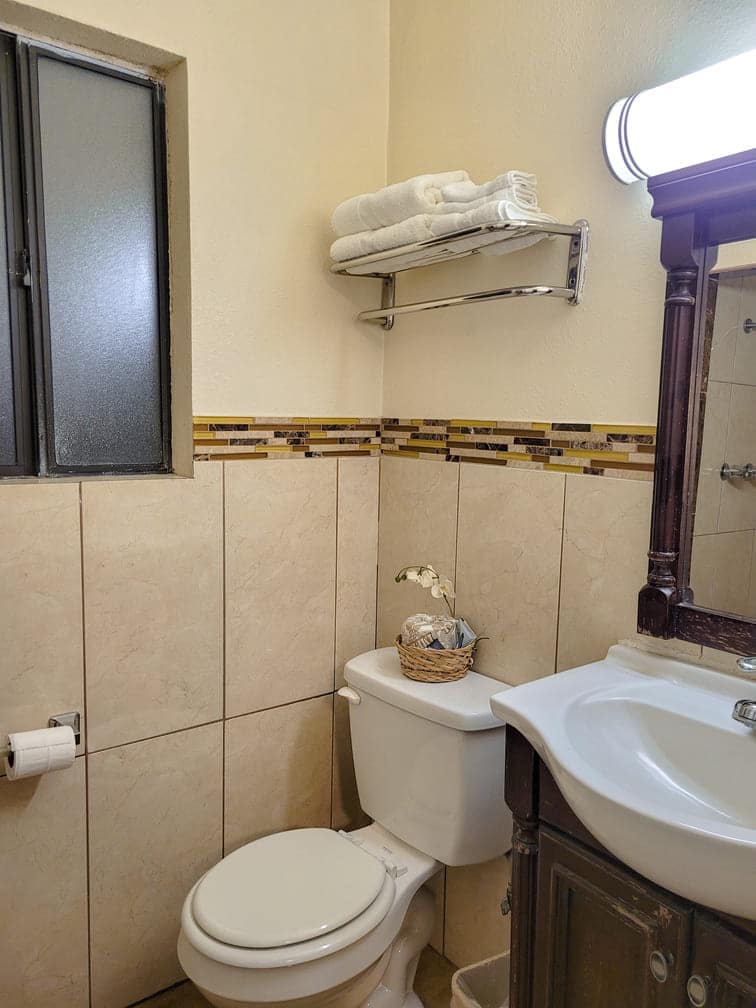
In my case, I chose to stay in the motel El Rancho Dolores at Twentynine Palms for 91€/night (2 people) and, although it was quite basic, the room was comfortable and clean, so I can recommend it.
Other options include staying in Joshua Tree or even Palm Springs, although the latter is a more distant option (50 minutes by car). If you have a tighter itinerary and less time available, staying in Twentynine Palms or Joshua Tree is definitely the best option.
Some of the accommodation options near Joshua Tree include:
Accommodation inside Joshua Tree National Park
Finally, it is also possible to camp inside the park. The park’s organization recommends that you book your camping site in advance, as there aren’t that many inside the park. There are two types of campsites at Joshua Tree:
- Campsites where reservation is required: Indian Cove, Black Rock, Jumbo Rock, Ryan, Cottonwood, Sheep Pass
- First-come, first-served campsites: Hidden Valley, Belle, White Tank
If you’re planning to camp in Joshua Tree, I recommend checking out the information about the campsites on the official website.
Is there any food in Joshua Tree?
An important tip when planning a trip to Joshua Tree is that there are no restaurants or supermarkets inside the park. To make the most of your time in the park, I suggest bringing some snacks for the day and a picnic for lunch.
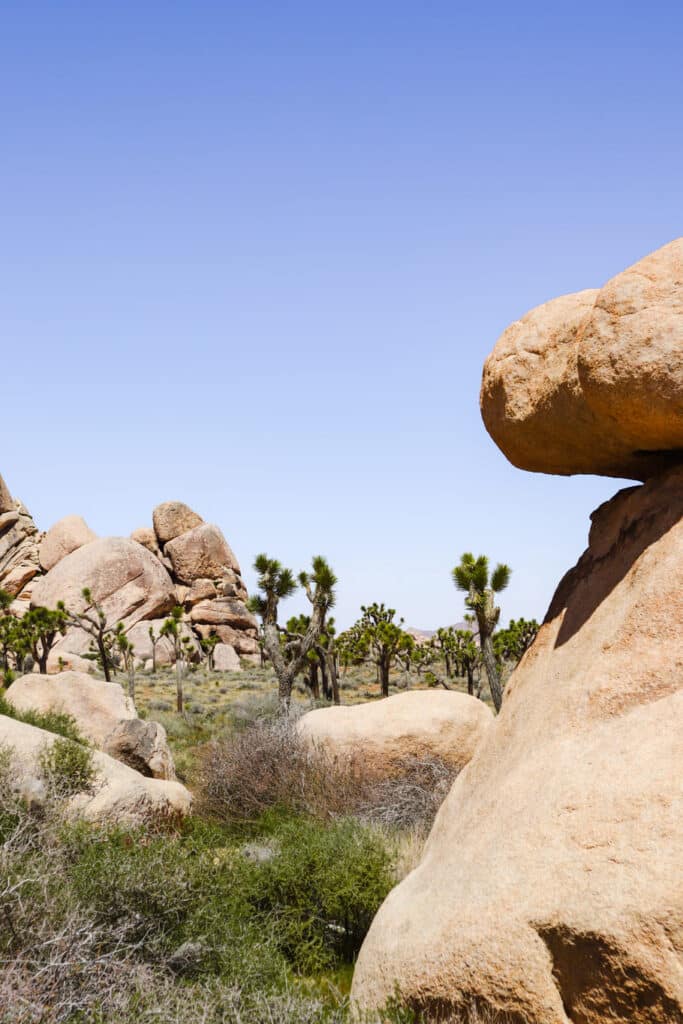
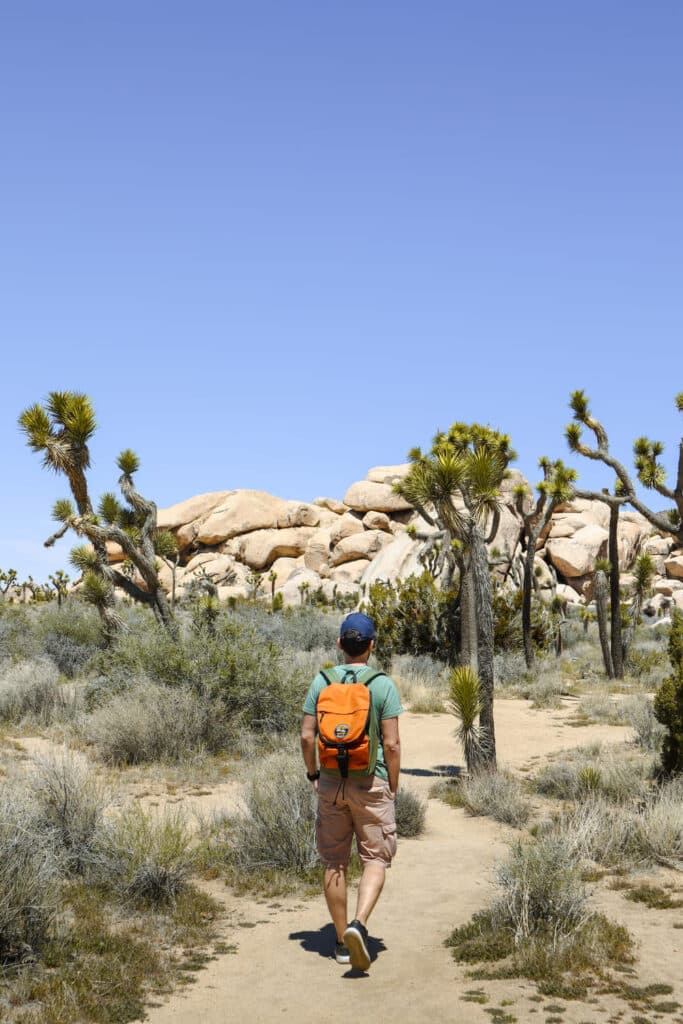
Joshua Tree National Park Map
Since the mobile service is quite limited inside the park, I suggest you carry a map of the park with you at all times, as well as downloading maps of the region offline beforehand.
As a general rule, you’ll be given a map and informative brochure at the park’s entrance, but here’s the Joshua Tree map in case you want to have a look before your trip. You can find maps of all the national parks in the United States here.

Joshua Tree National Park Itinerary for 1 Day
After all the practical tips I’ve provided you, it’s now time to show you my Joshua Tree one-day itinerary! This Joshua Tree National Park itinerary includes the park’s most emblematic sites and also some easy trails to experience the park even further.
This itinerary assumes that you enter Joshua Tree via the West Entrance! Below, I’m sharing an interactive map to help you plan your Joshua Tree National Park itinerary.
» Hidden Valley Trail
The Hidden Valley Trail is a very short trail and an easy Joshua tree hike. In this valley, we can find some of the many typical rock formations of Joshua Tree.

Its name (Hidden Valley) is related to the fact that this trail was used as a hideout by cattle thieves between the late 19th and early 20th centuries.

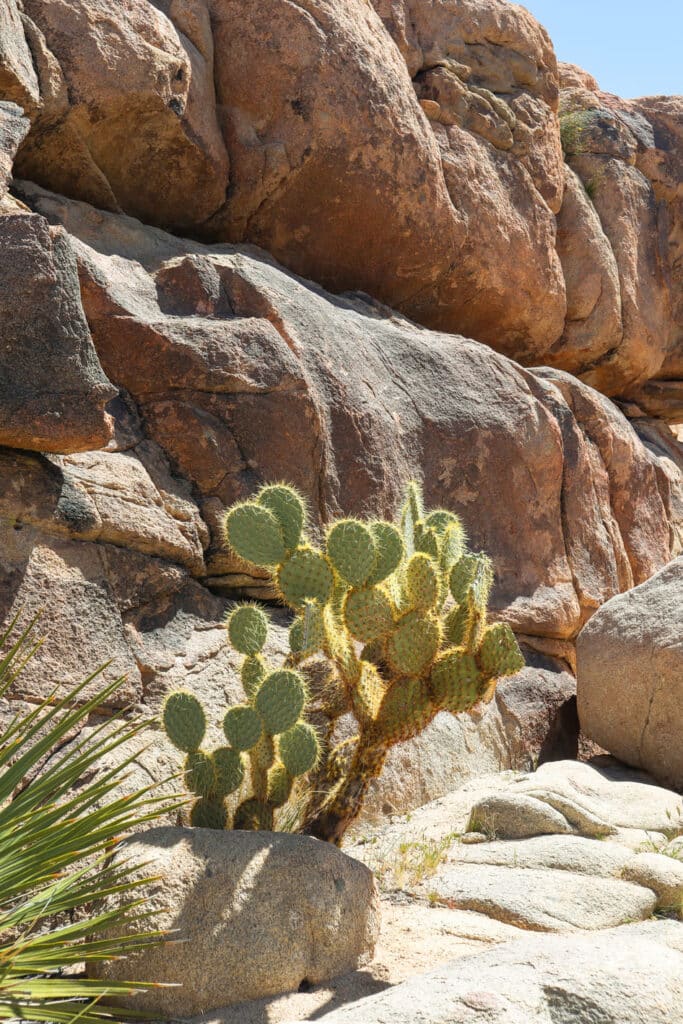
This is an excellent choice for a first experience in Joshua Tree National Park 🤩. As it’s one of the main points of interest to appear after the park’s most popular entrance, it fills up quite easily.
Useful information about the trail
- Distance: 1.6 km (1 mile) round trip loop
- Recommended duration: 45 minutes to 1 hour
- The trail is a loop and can be started either clockwise or anticlockwise
- Difficulty: Easy (however, there are some stairs)
- The terrain is slightly uneven and there is a bit of sand along the route
- Elevation: 30 meters (100 feet)
- Parking is available, but in high season it can fill up easily
» Cap Rock Nature Trail
When you search for this park online, the image that comes up most often is of the famous Joshua trees. After all, it is these trees that give the park its name. Although it is possible to see these typical trees in various places around the park, one of the best places to do so is on the Cap Rock Nature Trail.
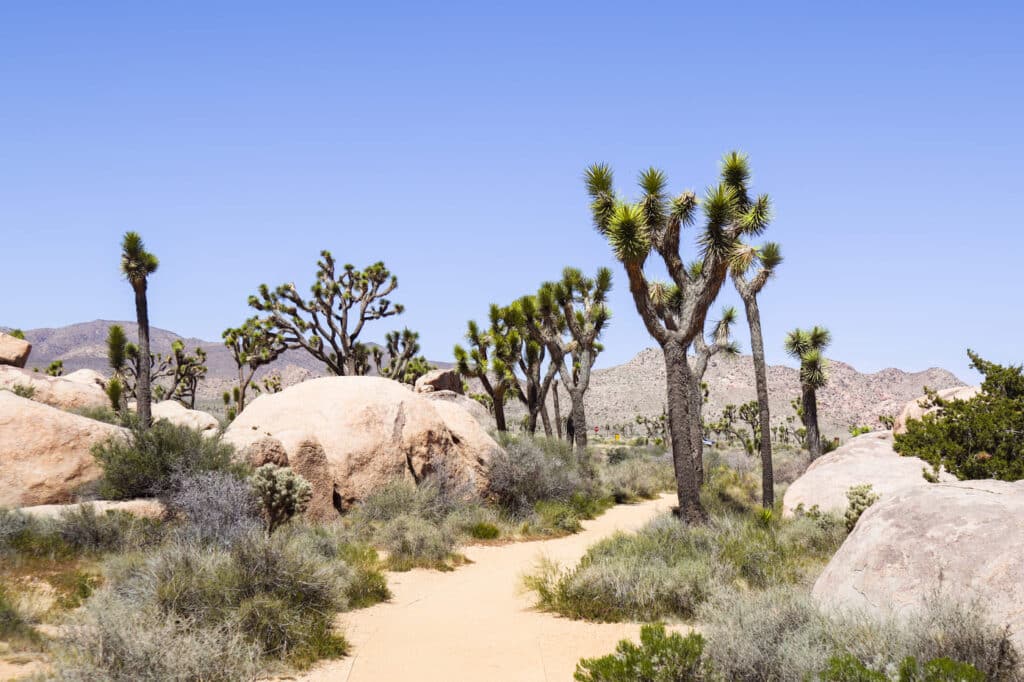
The trail is very easy and quick to follow, making it accessible to all ages and physical conditions. Along the way, there are some signs where you can learn a little more about Joshua Tree Park’s flora.
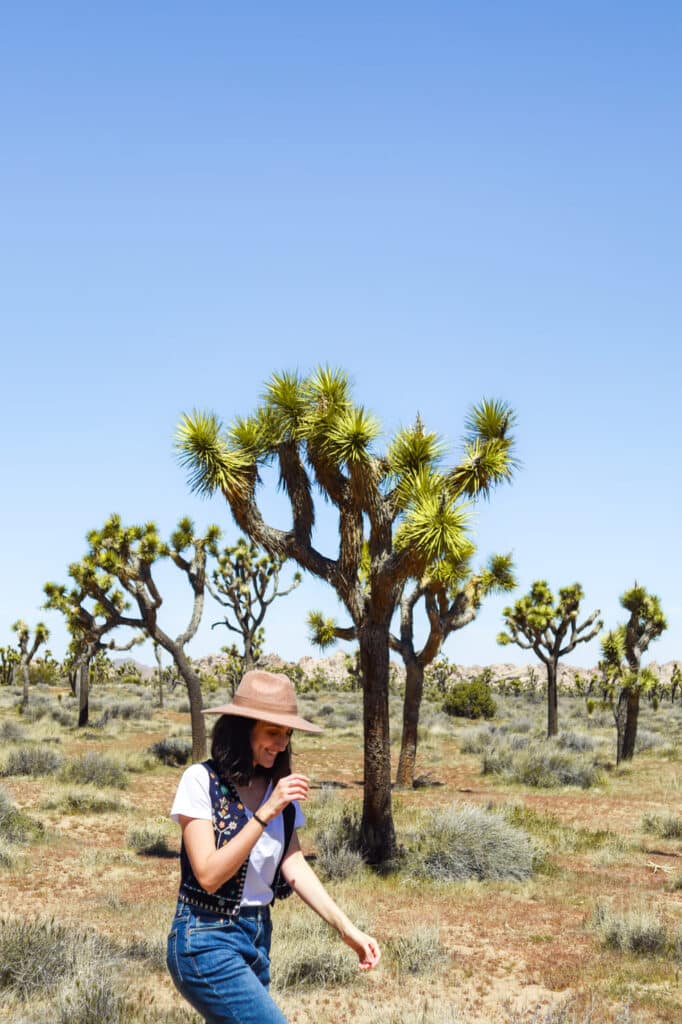
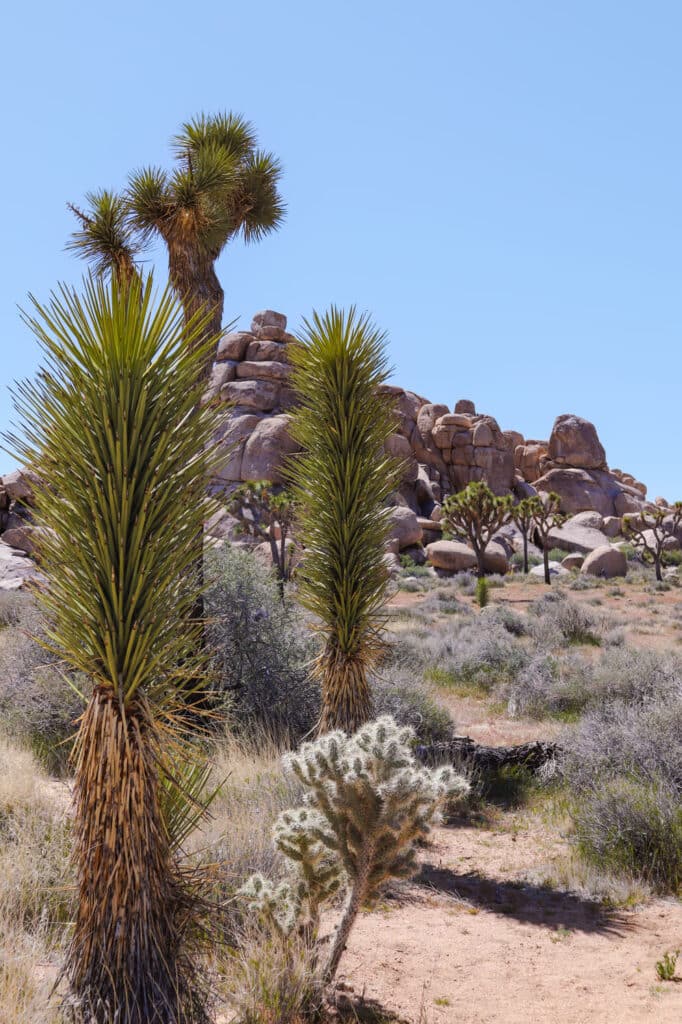
Useful information about the trail
- Distance: 0.6 km (0.4 miles) round trip loop
- Recommended duration: 30 to 45 minutes (depending on how much you stop for photos)
- Difficulty: Very easy
- Elevation: 6 meters (20 feet)
- Parking available
» Keys View
The landscapes in Joshua Tree can be diverse and Keys View is proof of this. It is one of the most popular viewpoints and should not be missed on a Joshua Tree National Park itinerary.
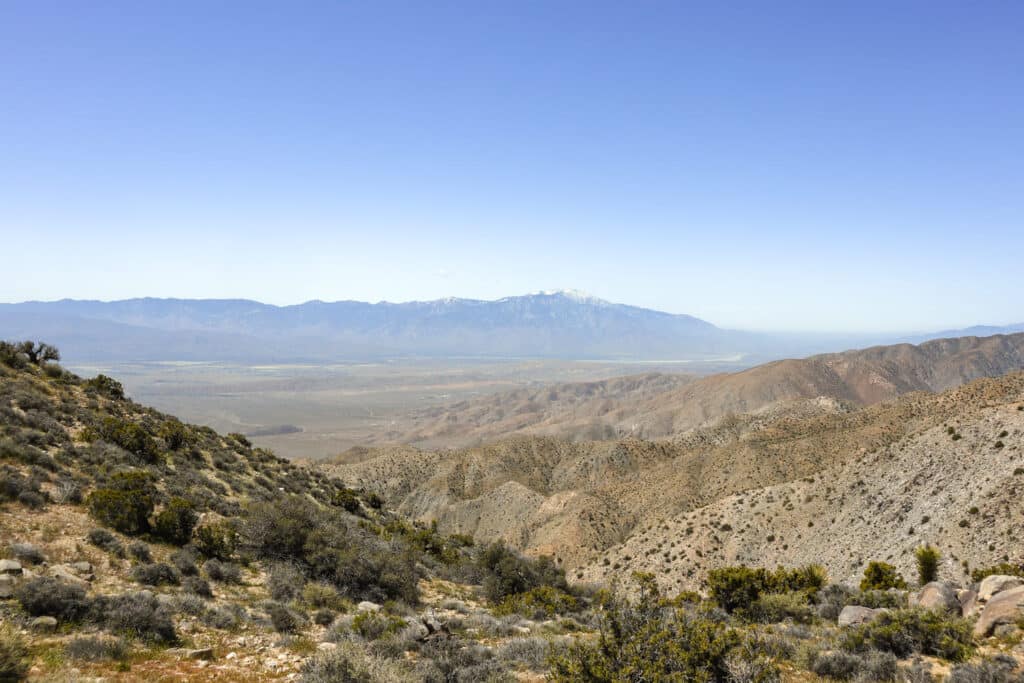
From Keys View you can see the San Andreas Fault (a fault that stretches for 1,200 km across California), Mount San Jacinto, Mount San Gorgonio, the Salton Sea and the Coachella Valley. On warmer days, the sky is often cloudy, which can affect the views from the lookout.
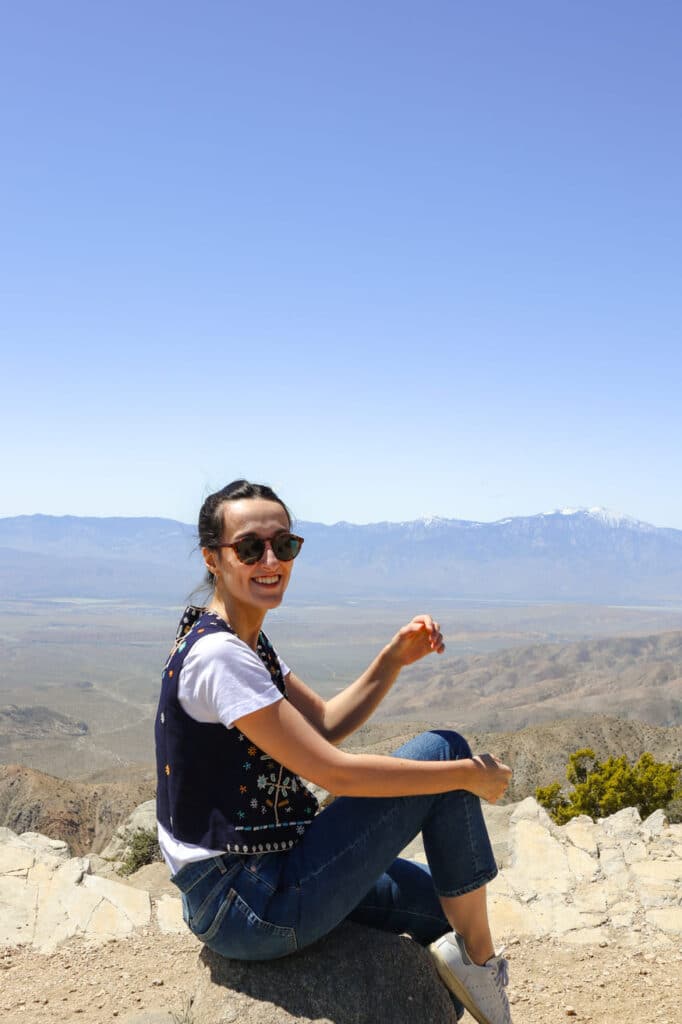
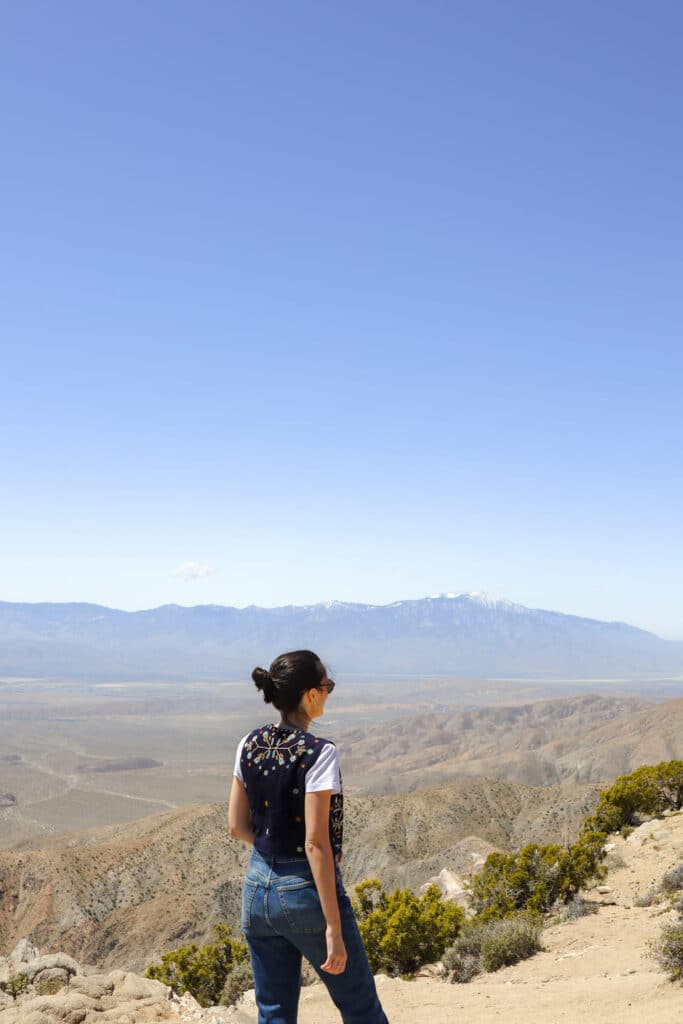
There is a parking lot right next to the viewpoint and from there, it is only a few meters walk to the viewpoint. As it is located in a higher part of the park, it is usually quite windy at this viewpoint.
» Hall of Horrors Trail
Don’t be daunted by the scary name of this trail, because it can be one of the most fun things to do in Joshua Tree. Although this is a particularly popular area for rock climbing in Joshua Tree National Park, the trail I recommend is relatively easy and short.
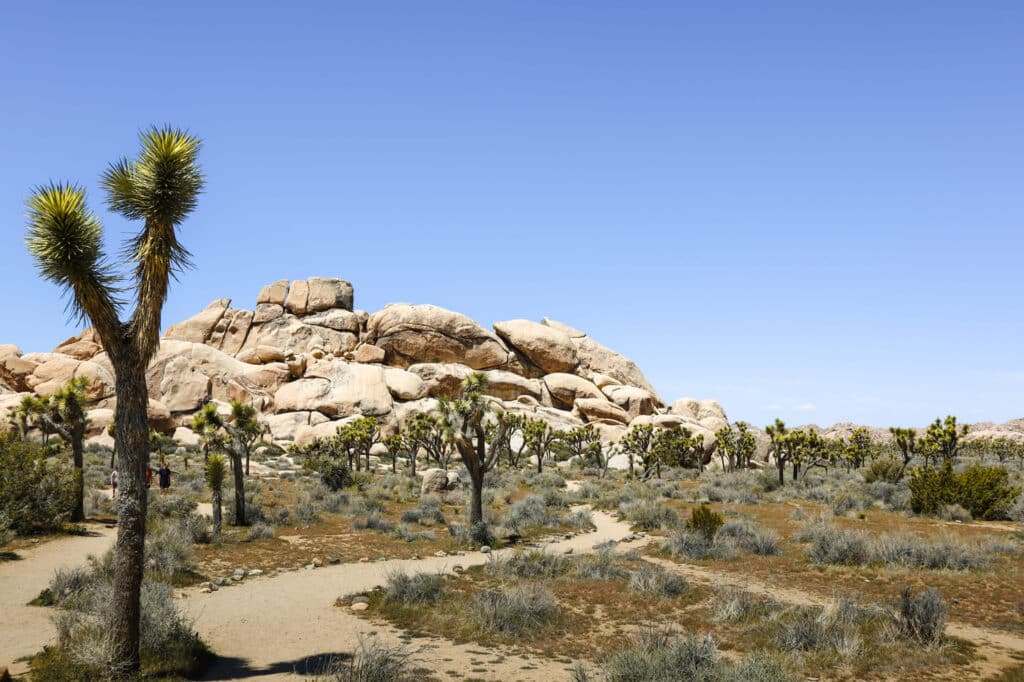
Much of the fun of this trail is trying to find the two hidden canyons among the gigantic boulders. Along the trail, you can observe the landscape and also see some Joshua trees, but that’s not the real reason to include the Hall of Horrors on this Joshua Tree itinerary.
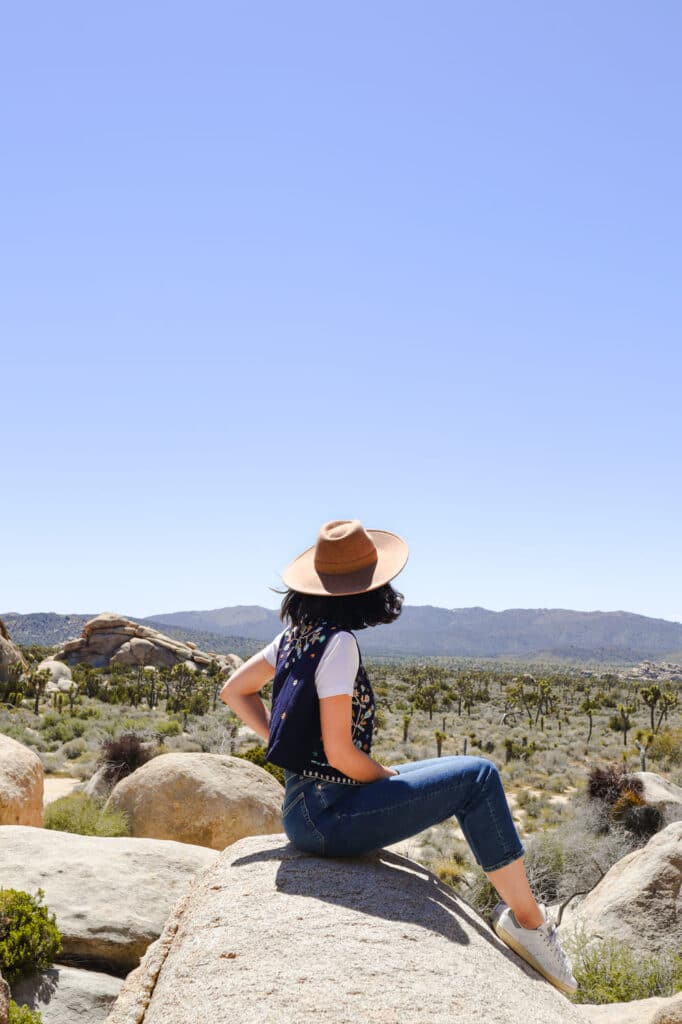
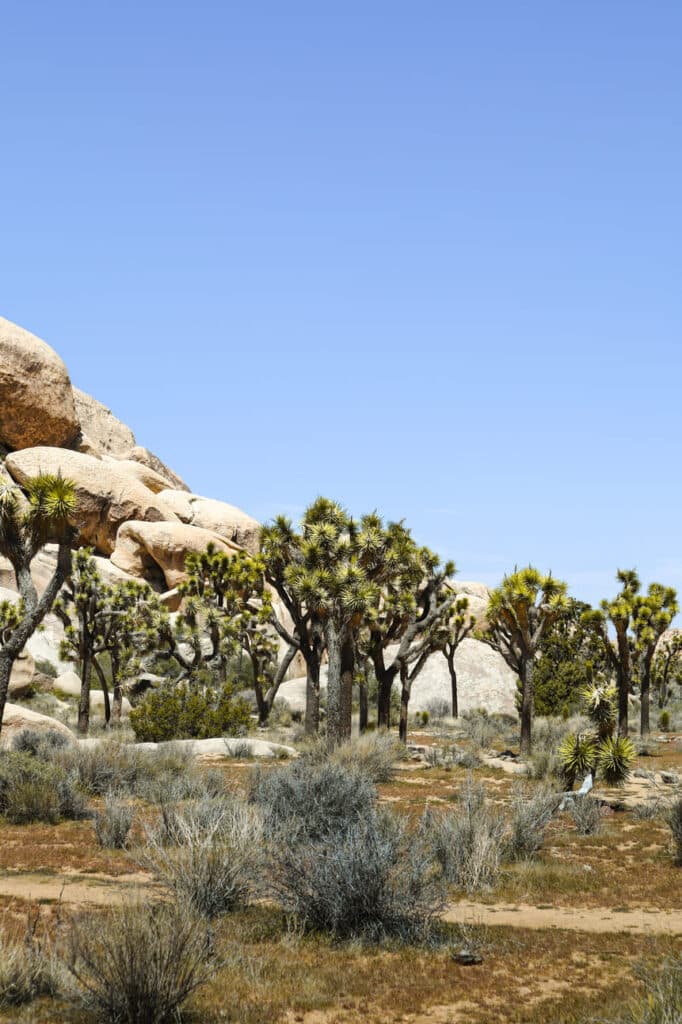
The trail starts at the Hall of Horrors parking lot and to find the hidden canyons you should start the trail clockwise. There are two groups big groups of boulders, and the canyons are located in the second group. The entrance to the canyons is easier than it looks, but I only entered the hidden canyon on the right as it seemed easier. Try to find it because you’ll have lots of fun. The canyon is very narrow, but it’s a lot of fun to go through 😁.
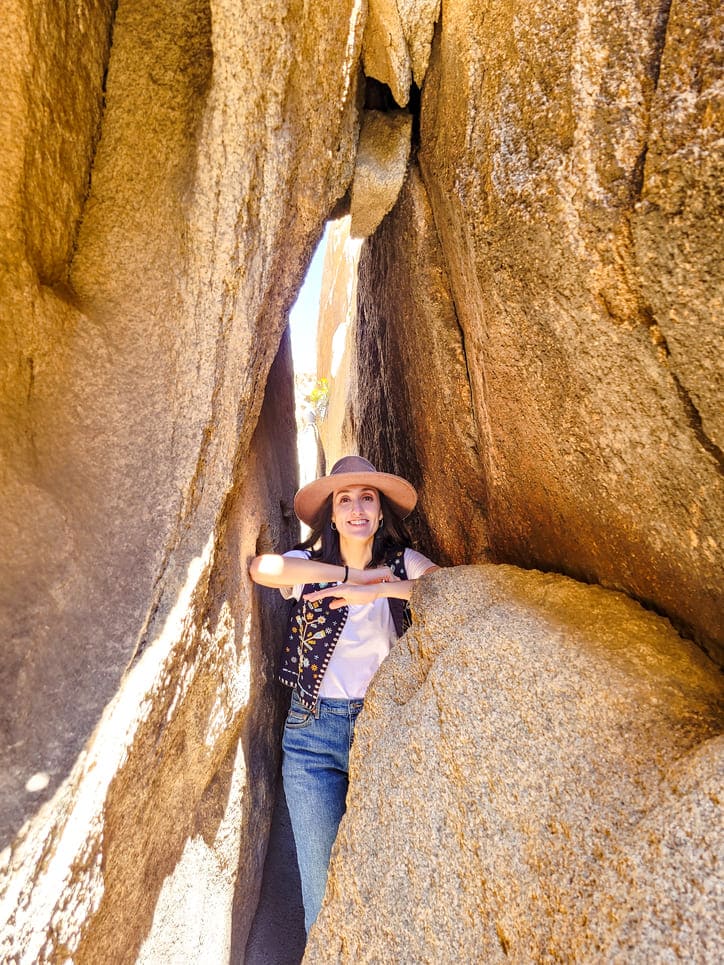

For more details and tips on the Halls of Horrors trail, I suggest reading this post, which is where I got my inspiration for my visit there. Note that you can also hike this trail without visiting the hidden canyons.
Useful information about the trail
- Distance: 1.3 km (0.8 miles) round trip loop
- Recommended duration: 1h to 1h30
- Difficulty: Moderate (the most difficult part is climbing inside the canyons)
- Elevation: 30 meters (100 feet)
- Parking available
» Skull Rock
Although this wasn’t one of my favourite places in Joshua Tree, I decided to include it in this itinerary because it’s one of the most popular places in the park. And, in fact, it was probably the most crowded place I visited while in the park.
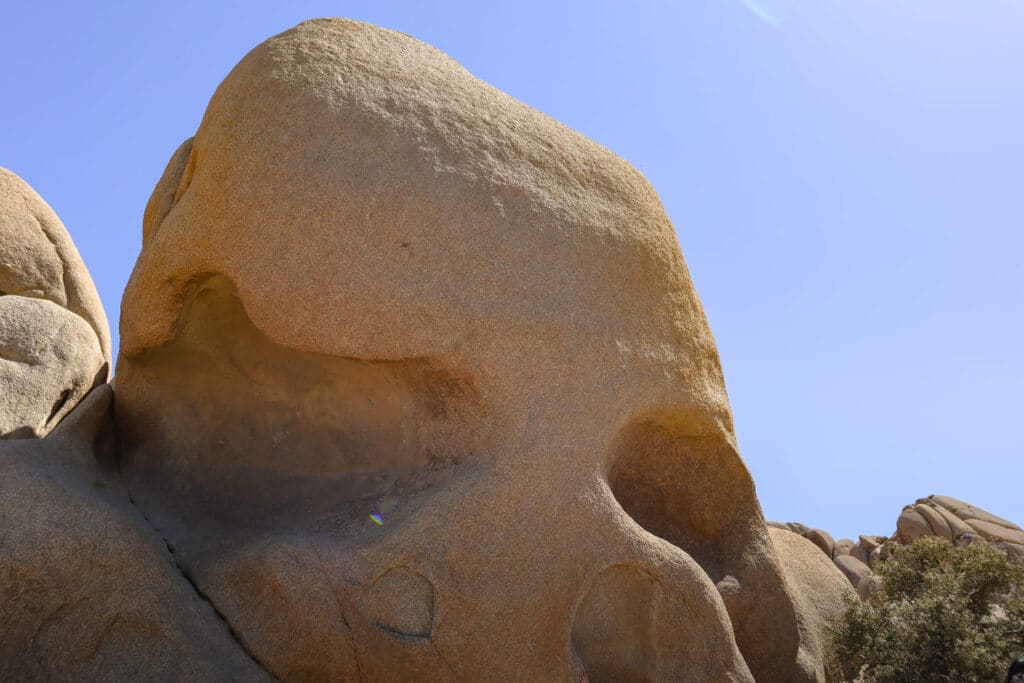
This is one of the best-known rock formations in the park because, from certain perspectives, it looks like a skull. Honestly, I didn’t find it very interesting, but visiting this site doesn’t take that long either.
💡 EXTRA TIP: Although I haven’t hiked these trails, if you have some time to spare, you can go on the Discovery Trail (1.1 km, 0.7 mi round trip) that connects Skull Rock with the Split Rock trail. Another option is the Skull Rock Trail (2.7 km, 1.7 mi round trip) which connects this rock with Jumbo Rocks.
» Arch Rock Trail
Time to head off to another trail, which is also quite an easy one. This trail is named after one of the best-known rock formations in the park – Arch Rock. As the name suggests, this is an arch-shaped rock.

I have to confess that seeing Arch Rock wasn’t the highlight of this trail, but rather witnessing the other rock formations along the trail. There’s even a heart-shaped rock (nicknamed Heart Rock)!
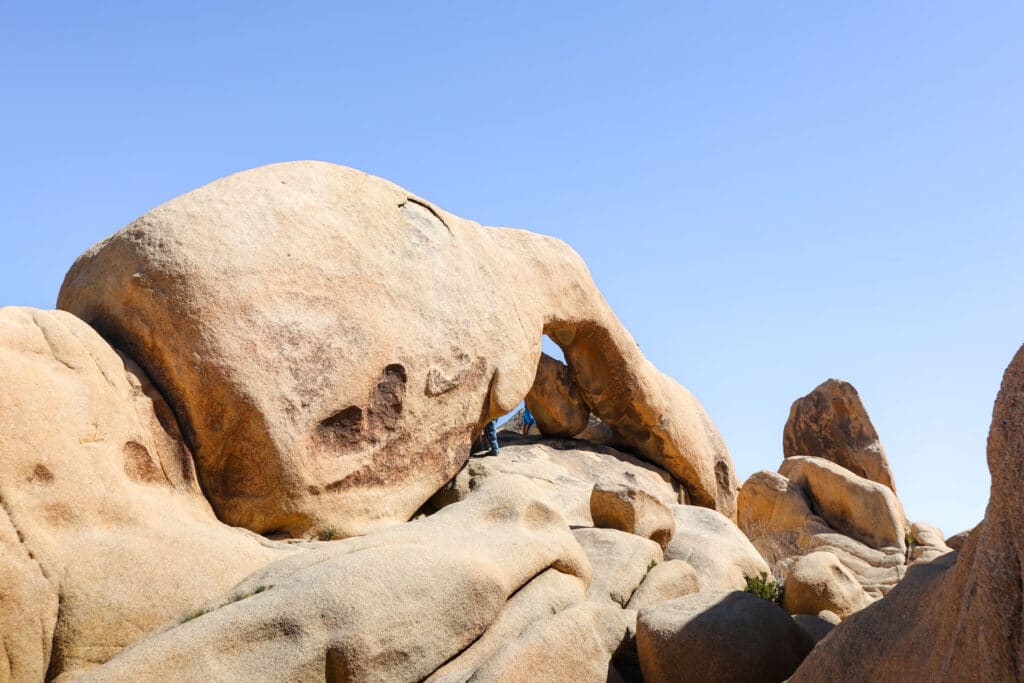
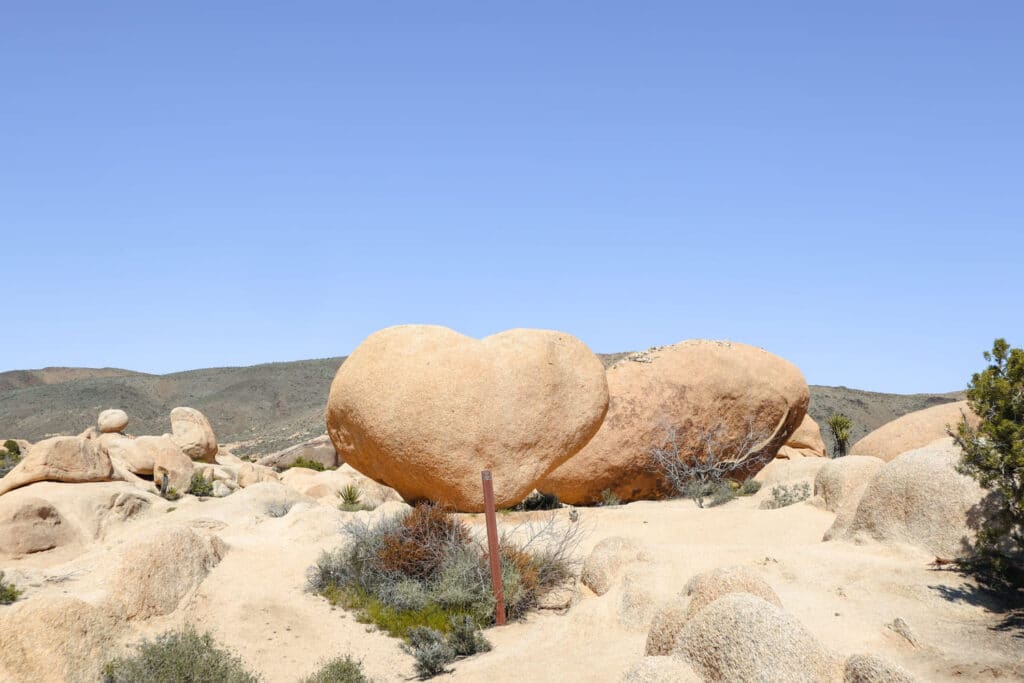
From the parking lot, the trail starts on the other side of Pinto Basin Road. There are several signs along the way for both Arch Rock and Heart Rock. The order in which you visit them is indifferent, as going to Heart Rock always involves a short, quick detour.
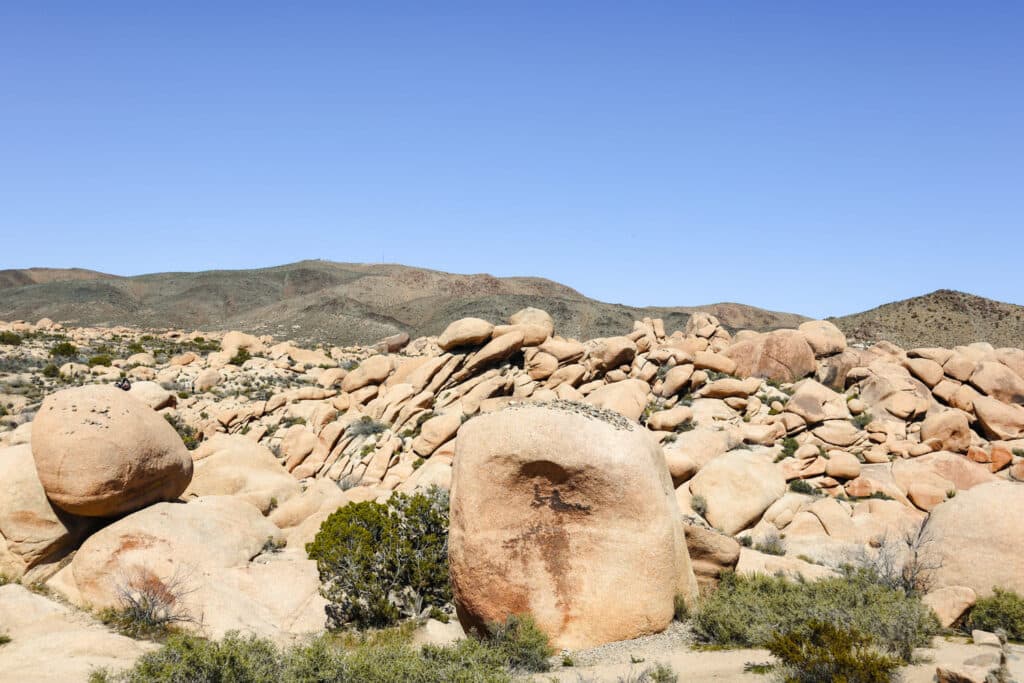
However, Arch Rock can be a little difficult to find. It took me a while to find it and several people had the same problem 😁. To make it easier for you to find it, here’s a tip: this arch is located near the start of the trail on the right side.
Useful information about the trail
- Distance: 2.9 km (1.8 miles) round trip
- Recommended duration: 1h30
- Difficulty: Easy
- Elevation: 30 metres (100 feet)
- There is parking available (you have to walk a bit from the car park to the start of the trail, and the distances indicated above already include the round trip from the car park).
» Cholla Cactus Garden
Cholla Cactus Garden is further proof that Joshua Tree has very diverse landscapes and it’s a must-see in Joshua Tree National Park. It’s a large garden full of cacti and one of the most beautiful places to photograph in the park.
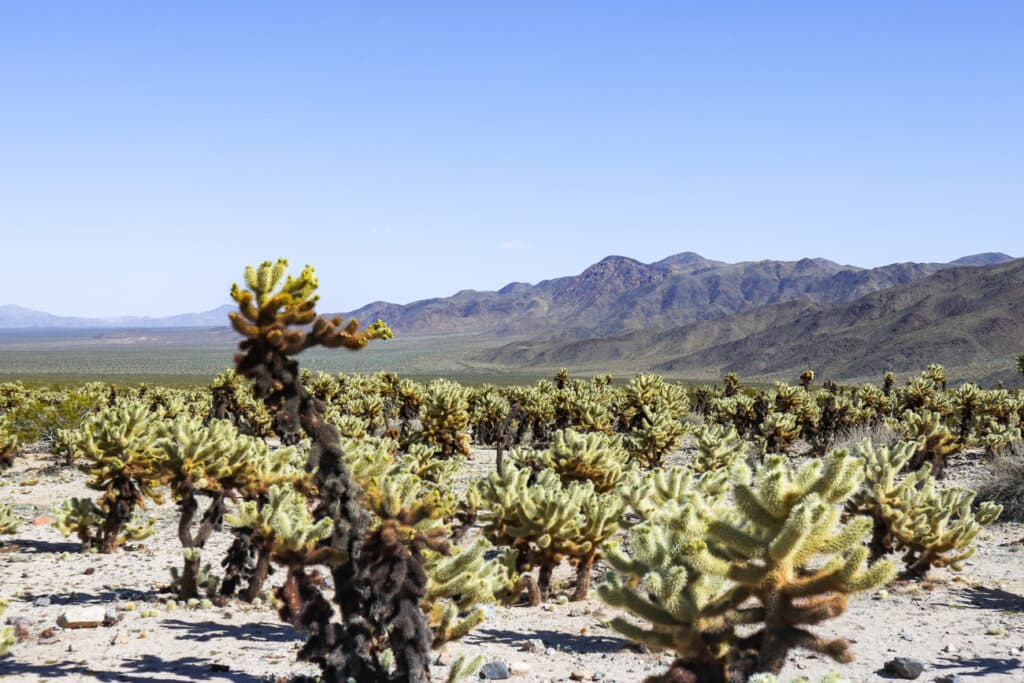
This site is a little further away from the others mentioned throughout this post, but it’s well worth including in your Joshua Tree National Park itinerary.
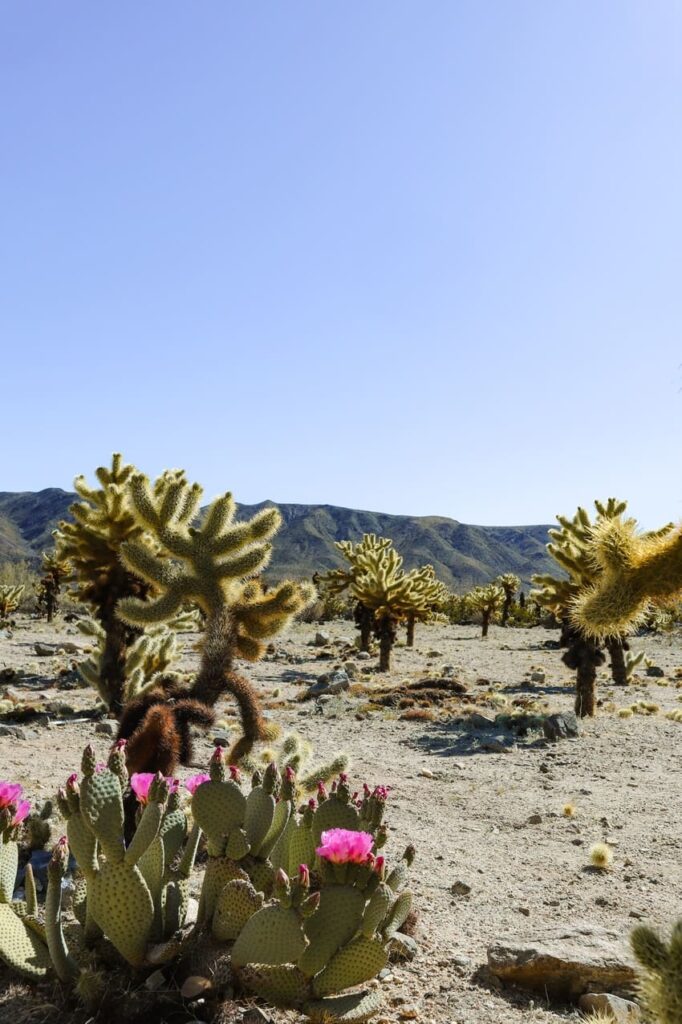

The type of cactus visible in this garden is known as cholla teddybear. However, despite the affectionate name, you should still be careful with the spikes! If you’re lucky enough to visit at sunset or sunrise, enjoy the magical colours in this garden😍!
» Cottonwood Spring Oasis
If you still have time, I have one last suggestion for this 1-day Joshua Tree itinerary. It’s called Cottonwood Spring Oasis and it is the most easily accessible oasis in the park, as it’s right next to the car park. It looks quite photogenic 🥰.
Unfortunately, I didn’t get the chance to visit, as it’s a little further out of the way than the other spots I visited in the park and I still had a long drive ahead on the day I visited. However, if you’re staying near Joshua Tree, it’s perfectly feasible to add this oasis to your itinerary.
Joshua Tree National Park Itinerary – What else to visit
If you’re one of the lucky ones who has more than one day available to visit Joshua Tree National Park, then I’m going to share a few more ideas of places to visit in the park. Please note that I haven’t visited any of these places myself, but I got curious about them when I was doing my research for this trip and organising my Joshua Tree itinerary.
Trails
- Barker Dam (1.8 km, 1.1 mi round trip)
- Oasis of Mara (0.8 km, 0.5 mi round trip)
- Ryan Ranch (1.6 km, 1 mi round trip)
- West Side Loop (7.6 km, 4.7 mi round trip)
- Ryan Mountain Trail (4.7 km, 3 mi round trip)
- Wall Street Mill (3.9 km, 2.4 mi round trip)
- Fortynine Palms Oasis (4.8 km, 3 mi round trip)

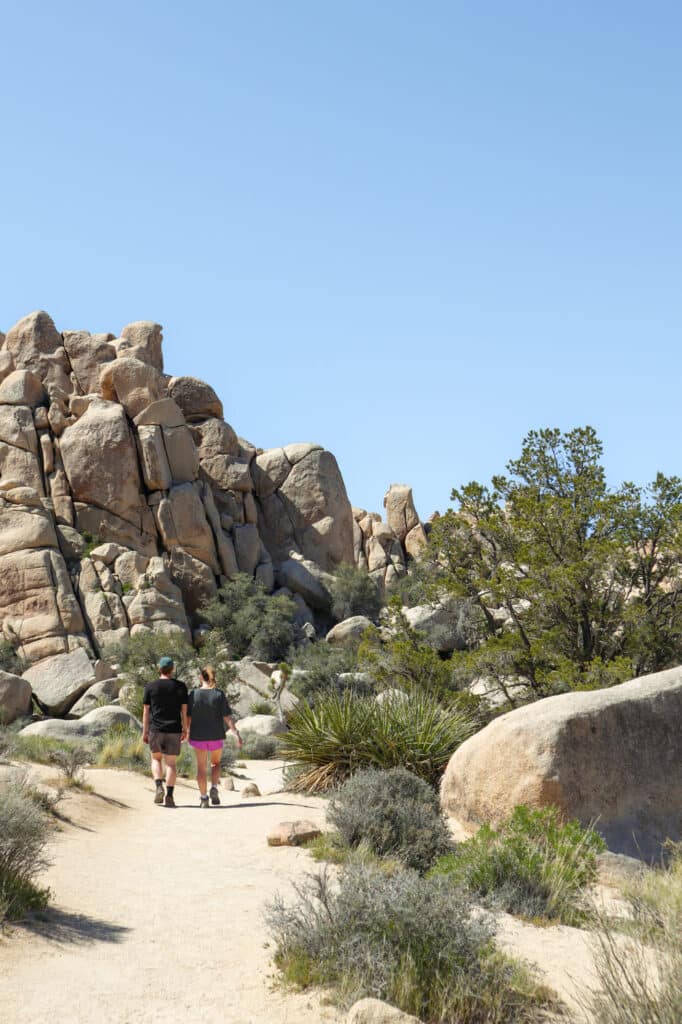
💡 EXTRA TIP: There’s no shortage of interesting trails in the park. Find out all about some of the best hikes in Joshua Tree National Park.
Rock climbing
Joshua Tree National Park is a very popular place for rock climbing. There are more than 8,000 climbing routes, making the park an attraction for climbing enthusiasts from all over the world.
Although experienced people can climb independently, there are also alternative options for those who have no experience and would like to learn a bit about climbing. Find out more about the climbing options at Joshua Tree here.
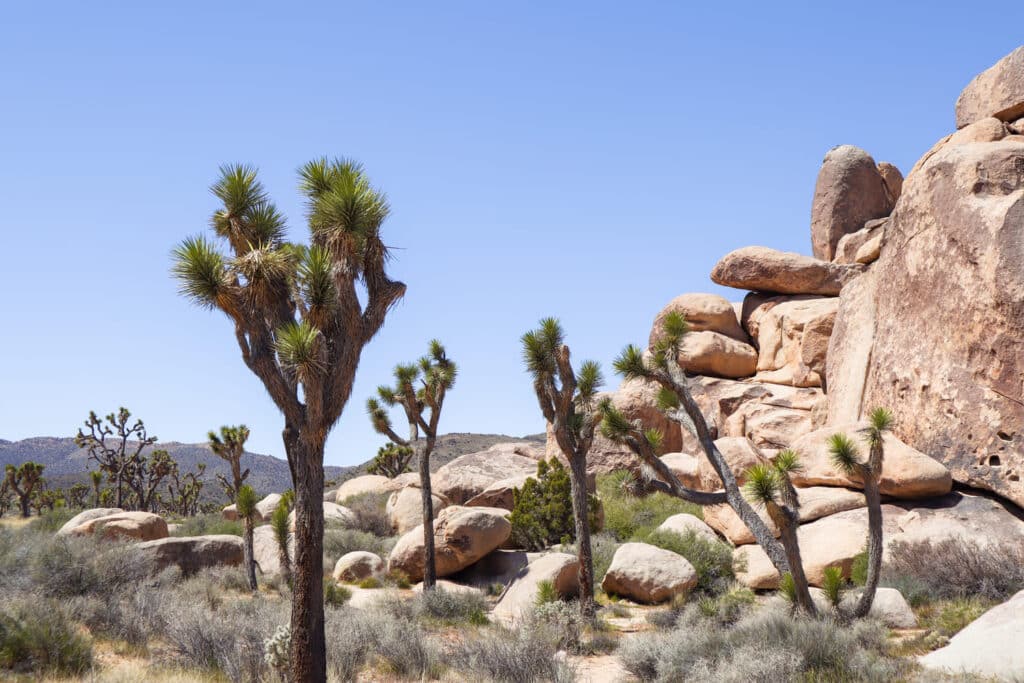
Other places of interest
- Split Rock – is also another of the park’s best-known rock formations. Nearby there is also a 4-kilometre circular trail (Split Rock Trail).
- Drive one of the many Joshua Tree dirt roads with a high-clearance vehicle – Believe me, this is one of the most fun activities you can do in US national parks, and it turns out to be a less crowded option as it requires a high-clearance vehicle (4×4). Some of these roads in Joshua Tree include Berdoo Canyon Road, Old Dale Road, Black Eagle Mine Road, Pinkham Canyon Road, Covington Road to Eureka Peak and Geology Tour Road.
- Eureka Peak – a beautiful viewpoint of the San Bernardino and Santa Rosa Mountains. However, you need a 4×4 vehicle to get here.
- Admire the starry night sky – one of the most popular night-time activities in the park. More tips for this activity on the park’s official website.
Tips for walking trails in Joshua Tree
Hiking trails in Joshua Tree are super interesting and amusing. However, depending on the weather conditions at the time of your visit, you should take some aspects into consideration. These are some of the park’s official recommendations:
- Protect from the sun with a hat, sunglasses, light clothing and suncream
- Ensure the necessary hydration while hiking any trail
- Make sure you have food when you enter the park as there is nowhere to buy food inside the park
- Plan your visit in advance to avoid going on the trails at the hottest time of the day
- In the colder months, it’s important to be prepared for cold temperatures
- On days with fewer hours of daylight, make sure you return from the trail when there is still light since it gets dark earlier
- If you’re going to walk a trail alone, tell someone you know that you’re doing it
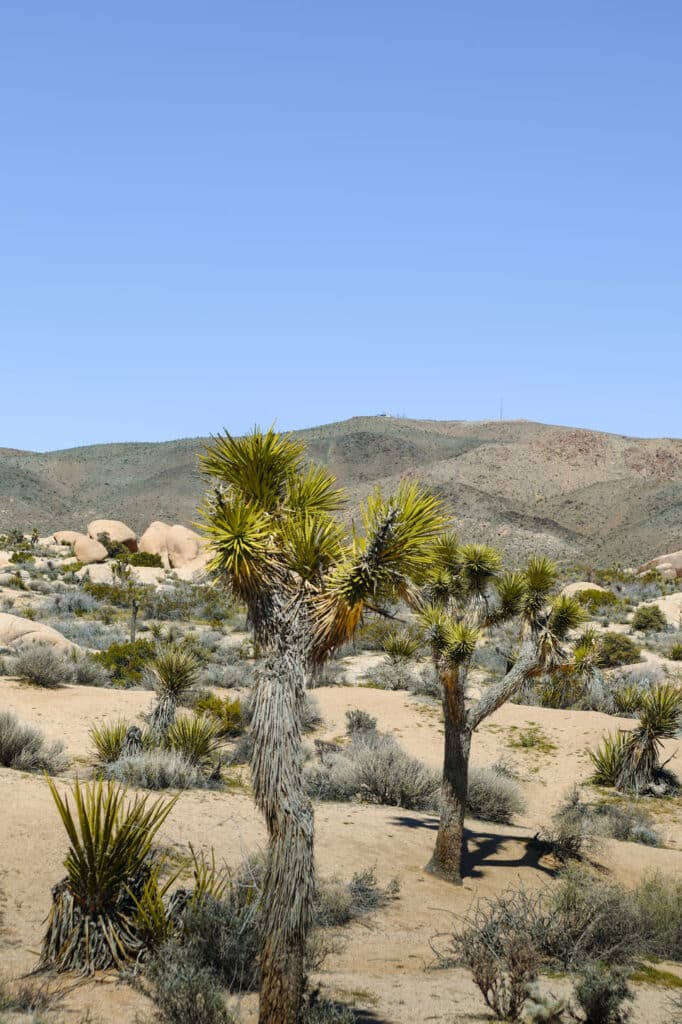

Finally, don’t forget the Leave No Trace principle, by complying with its 7 principles: prepare your visit in advance, dispose of rubbish in appropriate places, leave everything the same way as you found it, minimise the impact of any campfires, respect wildlife, be respectful to other visitors and comply with the camping rules.
Disclaimer: this post may contain some affiliate links, which means I get a small commission if you buy something through my links. This doesn’t represent any additional cost to you and you’ll be supporting my work here on the blog😊

